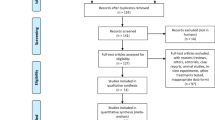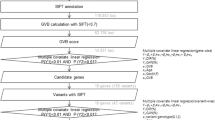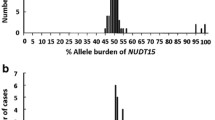Abstract
Background
Thiopurines, commonly used to treat autoimmune conditions and cancer, can be limited by life-threatening leucopenia. However, whether NUDT15 (nucleoside diphosphate-linked moiety X-type motif 15) is associated with thiopurine-induced leucopenia in Asians is controversial.
Methods
Relevant studies in English that were published until July 10, 2016 were identified through PubMed, EMbase, and other web knowledge databases. Study quality was assessed according to the Newcastle-Ottawa Scale (NOS) criteria. Summary risk ratio (RR) and 95% confidence intervals (CI) were estimated based on a fixed-effects model or a random-effects model, depending on the absence or presence of significant heterogeneity.
Results
Seven studies of 1138 patients met our inclusion criteria. Random-effects model meta-analysis provided evidence that T carriers of NUDT15 c.415C>T were significantly correlated with high incidences of thiopurine-induced leukocytopenia [CT + TT vs. CC: RR = 3.79, 95%CI (2.64 ~ 5.44), P < 0.00001]. This correlation was especially strong in TT patients, where it was found to be significantly increased by 6.54-fold compared with CC patients [TT vs. CC: RR = 6.54, 95%CI (3.34 ~ 12.82), P < 0.00001]. We also found that the NUDT15 c.415C>T variant was common in Asians and Hispanics, but rare in Europeans and Africans; the frequency of the NUDT15 c.415C>T distribution varied substantially by race/ethnicity.
Conclusion
The results of this meta-analysis confirm that NUDT15 c.415C>T may be an important predictor of thiopurine-induced leukocytopenia in Asians. Genotype targeting of NUDT15 c.415C>T before initiating thiopurine treatment may be useful to limit leukocytopenia.




Similar content being viewed by others
References
Anstey A, Lear JT (1998) Azathioprine: clinical pharmacology and current indications in autoimmune disorders. BioDrugs 9:33–47
Lennard L, Van Loon JA, Weinshilboum RM (1989) Pharmacogenetics of acute azathioprine toxicity: relationship to thiopurine methyltransferase genetic polymorphism. Clin Pharmacol Ther 46:149–154
Evans WE, Horner M, Chu YQ, Kalwinsky D, Roberts WM (1991) Altered mercaptopurine metabolism, toxic effects, and dosage requirement in a thiopurine methyltransferase-deficient child with acute lymphocytic leukemia. J Pediatr 119:985–989
Lennard L, Lilleyman JS, Van Loon J, Weinshilboum RM (1990) Genetic variation in response to 6-mercaptopurine for childhood acute lymphoblastic leukaemia. Lancet 336:225–229
Lennard L, Van Loon JA, Lilleyman JS, Weinshilboum RM (1987) Thiopurine pharmacogenetics in leukemia: correlation of erythrocyte thiopurine methyltransferase activity and 6-thioguanine nucleotide concentrations. Clin Pharmacol Ther 41:18–25
Relling MV, Gardner EE, Sandborn WJ et al (2013) Clinical pharmacogenetics implementation consortium guidelines for thiopurine methyltransferase genotype and thiopurine dosing: 2013 update. Clin Pharmacol Ther 93:324–325
Roberts RL, Barclay ML (2015) Update on thiopurine pharmacogenetics in inflammatory bowel disease. Pharmacogenomics 16:891–903
McLeod HL, Pritchard SC, Githang'a J et al (1999) Ethnic differences in thiopurine methyltransferase pharmacogenetics: evidence for allele specificity in Caucasian and Kenyan individuals. Pharmacogenetics 9:773–776
Collie-Duguid ES, Pritchard SC, Powrie RH et al (1999) The frequency and distribution of thiopurine methyltransferase alleles in Caucasian and Asian populations. Pharmacogenetics 9:37–42
Kim JH, Cheon JH, Hong SS et al (2010) Influences of thiopurine methyltransferase genotype and activity on thiopurine-induced leukopenia in Korean patients with inflammatory bowel disease: a retrospective cohort study. J Clin Gastroenterol 44:e242–e248
Tajiri H, Tomomasa T, Yoden A et al (2008) Efficacy and safety of azathioprine and 6-mercaptopurine in Japanese pediatric patients with ulcerative colitis: a survey of the Japanese Society for Pediatric Inflammatory Bowel Disease. Digestion 77:150–154
Takatsu N, Matsui T, Murakami Y et al (2009) Adverse reactions to azathioprine cannot be predicted by thiopurine S-methyltransferase genotype in Japanese patients with inflammatory bowel disease. J Gastroenterol Hepatol 24:1258–1264
Asada A, Nishida A, Shioya M et al (2016) NUDT15 R139C-related thiopurine leukocytopenia is mediated by 6-thioguanine nucleotide-independent mechanism in Japanese patients with inflammatory bowel disease. J Gastroenterol 51:22–29
Lee YJ, Hwang EH, Park JH et al (2016) NUDT15 variant is the most common variant associated with thiopurine-induced early leukopenia and alopecia in Korean pediatric patients with Crohn’s disease. Eur J Gastroenterol Hepatol. doi:10.1097/MEG.0000000000000564
Liang DC, Yang CP, Liu HC et al (2015) NUDT15 gene polymorphism related to mercaptopurine intolerance in Taiwan Chinese children with acute lymphoblastic leukemia. Pharmacogenomics J 16:536–539
N. NCI (2009) National Cancer Institute, common terminology criteria for adverse events v4. NIH publication, Bethesda 09-7473
Stang A (2010) Critical evaluation of the Newcastle-Ottawa scale for the assessment of the quality of nonrandomized studies in meta-analyses. Eur J Epidemiol 25:603–605
Zintzaras E, Ioannidis JP (2005) HEGESMA: genome search meta-analysis and heterogeneity testing. Bioinformatics 21:3672–3673
Peters JL, Sutton AJ, Jones DR et al (2006) Comparison of two methods to detect publication bias in meta-analysis. JAMA 295:676–680
Chiengthong K, Ittiwut C, Muensri S et al (2016) NUDT15 c.415C>T increases risk of 6-mercaptopurine induced myelosuppression during maintenance therapy in children with acute lymphoblastic leukemia. Haematologica 101:e24–e26
Kakuta Y, Naito T, Onodera M et al (2015) NUDT15 R139C causes thiopurine-induced early severe hair loss and leukopenia in Japanese patients with IBD. Pharmacogenomics J 16:280–285
Tanaka Y, Kato M, Hasegawa D et al (2015) Susceptibility to 6-MP toxicity conferred by a NUDT15 variant in Japanese children with acute lymphoblastic leukaemia. Br J Haematol 171:109–115
Yang SK, Hong M, Baek J et al (2014) A common missense variant in NUDT15 confers susceptibility to thiopurine-induced leukopenia. Nat Genet 46:1017–1020
Zhu X, Chao K, Wang X et al (2016) NUDT15 R139C genotype is a determinant of thiopurines-induced leukopenia in Chinese patients with Crohn’s disease. Gastroenterology 150:S318
Shah SA, Paradkar M, Desai D et al (2016) Nudt15 C415t variant as a predictor for thiopurine induced toxicity in Indian patients. J Gastroenterol Hepatol. doi:10.1111/jgh.13494
Suzuki H, Fukushima H, Suzuki R et al (2016) Genotyping NUDT15 can predict the dose reduction of 6-MP for children with acute lymphoblastic leukemia especially at a preschool age. J Hum Genet 61:797–801
Yang JJ, Landier W, Yang W et al (2015) Inherited NUDT15 variant is a genetic determinant of mercaptopurine intolerance in children with acute lymphoblastic leukemia. J Clin Oncol 33:1235–1242
Meijer B, Mulder CJ, de Boer NK (2016) NUDT15: a novel player in thiopurine metabolism. J Gastrointestin Liver Dis 25:261–262
Ebbesen MS, Nersting J, Jacobsen JH et al (2013) Incorporation of 6-thioguanine nucleotides into DNA during maintenance therapy of childhood acute lymphoblastic leukemiaThe influence of thiopurine methyltransferase genotypes. J Clin Pharmacol 53:670–674
Fotoohi AK, Coulthard SA, Albertioni F (2010) Thiopurines: factors influencing toxicity and response. Biochem Pharmacol 79:1211–1220
Hedeland RL, Hvidt K, Nersting J et al (2010) DNA incorporation of 6-thioguanine nucleotides during maintenance therapy of childhood acute lymphoblastic leukaemia and non-Hodgkin lymphoma. Cancer Chemother Pharmacol 66:485–491
Takagi Y, Setoyama D, Ito R et al (2012) Human MTH3 (NUDT18) protein hydrolyzes oxidized forms of guanosine and deoxyguanosine diphosphates: comparison with MTH1 and MTH2. J Biol Chem 287:21541–21549
Moriyama T, Nishii R, Perez-Andreu V et al (2016) NUDT15 polymorphisms alter thiopurine metabolism and hematopoietic toxicity. Nat Genet 48:367–373
Author information
Authors and Affiliations
Corresponding author
Ethics declarations
Conflict of interest
The authors declare that they have no conflict of interest.
Source of funding
This study was funded by the Science and Technology Planning Project of Henan Province, China (grant number 201601001).
Rights and permissions
About this article
Cite this article
Zhang, A.L., Yang, J., Wang, H. et al. Association of NUDT15 c.415C>T allele and thiopurine-induced leukocytopenia in Asians: a systematic review and meta-analysis. Ir J Med Sci 187, 145–153 (2018). https://doi.org/10.1007/s11845-017-1608-x
Received:
Accepted:
Published:
Issue Date:
DOI: https://doi.org/10.1007/s11845-017-1608-x




